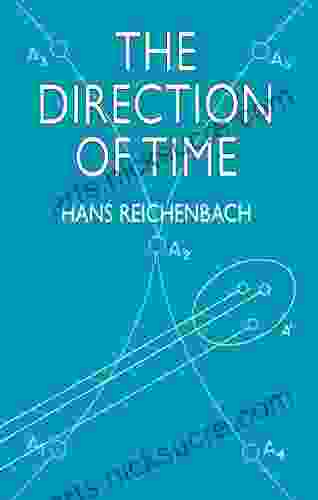The Direction of Time: A Journey Through the Physics of Causality

4.4 out of 5
| Language | : | English |
| File size | : | 3969 KB |
| Text-to-Speech | : | Enabled |
| Screen Reader | : | Supported |
| Enhanced typesetting | : | Enabled |
| Word Wise | : | Enabled |
| Print length | : | 305 pages |
| Lending | : | Enabled |
The concept of time's direction is a profound enigma that has puzzled philosophers and physicists for centuries. Why does time flow in one direction, from past to future? Why is it impossible to reverse the order of events? The answers to these questions lie at the heart of our understanding of the universe and our place within it.
In this article, we will embark on a journey through the physics of time's direction, exploring the fundamental principles of causality, entropy, and the arrow of time. We will delve into the complexities of special relativity, general relativity, and quantum mechanics, unraveling the secrets of time dilation, time travel, and time reversal. Along the way, we will encounter some of the most brilliant minds in physics, including Albert Einstein, Richard Feynman, and Stephen Hawking.
Causality and the Arrow of Time
The first clue to understanding time's direction lies in the concept of causality. Causality is the relationship between cause and effect. In simple terms, an event (the cause) brings about another event (the effect). For example, dropping a glass on the floor causes it to break.
The laws of physics are time-symmetric, meaning that they do not distinguish between past and future. However, the universe itself is not time-symmetric. There is a clear distinction between cause and effect, and this distinction gives rise to the arrow of time.
The arrow of time points from the past to the future. This means that the past is fixed and cannot be changed, while the future is open and uncertain. The arrow of time is a fundamental aspect of our universe, and it plays a crucial role in our perception of reality.
Entropy and the Second Law of Thermodynamics
Another key to understanding time's direction is the concept of entropy. Entropy is a measure of disorder. In general, the entropy of a closed system increases over time. This means that the universe is becoming increasingly disordered as time goes on.
The second law of thermodynamics states that the total entropy of an isolated system can never decrease. This law is one of the most fundamental laws of physics, and it has profound implications for our understanding of time's direction.
The second law of thermodynamics tells us that the universe is constantly moving towards a state of maximum entropy. This means that the future is more likely to be disordered than the past. The arrow of time is consistent with the second law of thermodynamics, as it suggests that the universe is evolving towards a state of greater disorder.
Special Relativity and Time Dilation
Special relativity is a theory of space and time developed by Albert Einstein in 1905. Special relativity has a number of implications for our understanding of time's direction.
One of the most important implications of special relativity is that time dilation occurs. Time dilation is the phenomenon where time passes slower for objects that are moving relative to an observer. This means that if you travel at a high speed, you will experience less time passing than someone who is stationary.
Time dilation has a number of applications, including GPS navigation and particle accelerators. However, it also has implications for our understanding of time's direction. Time dilation suggests that the arrow of time is not absolute, but rather relative to the observer.
General Relativity and Gravitational Time Dilation
General relativity is a theory of gravity developed by Albert Einstein in 1915. General relativity has a number of implications for our understanding of time's direction.
One of the most important implications of general relativity is that gravitational time dilation occurs. Gravitational time dilation is the phenomenon where time passes slower in a stronger gravitational field. This means that if you are near a massive object, such as a black hole, you will experience less time passing than someone who is further away.
Gravitational time dilation has a number of applications, including astronomy and cosmology. However, it also has implications for our understanding of time's direction. Gravitational time dilation suggests that the arrow of time is not only relative to the observer, but also to the gravitational field.
Quantum Mechanics and Time Reversal
Quantum mechanics is a theory of the behavior of matter at the atomic and subatomic level. Quantum mechanics has a number of implications for our understanding of time's direction.
One of the most important implications of quantum mechanics is that time reversal is possible. Time reversal is the phenomenon where the direction of time is reversed. This means that if you were to record a video of a quantum mechanical system, and then play it backwards, the system would appear to be evolving in reverse.
Time reversal is not possible in classical physics. However, it is possible in quantum mechanics. This suggests that the arrow of time is not as fundamental as we once thought.
The Mysteries of Time's Direction
The direction of time is one of the most fundamental and mysterious aspects of our universe. We have made great progress in understanding time's direction, but there are still many unanswered questions.
One of the biggest mysteries is why the universe is not time-symmetric. Why is it that the laws of physics do not distinguish between past and future, but the universe itself does?
Another mystery is why the arrow of time is consistent with the second law of thermodynamics. Why is it that the universe is constantly moving towards a state of maximum entropy?
These are just a few of the mysteries that surround the direction of time. As we continue to explore the fundamental nature of our universe, we may one day come to understand the true nature of time's direction.
4.4 out of 5
| Language | : | English |
| File size | : | 3969 KB |
| Text-to-Speech | : | Enabled |
| Screen Reader | : | Supported |
| Enhanced typesetting | : | Enabled |
| Word Wise | : | Enabled |
| Print length | : | 305 pages |
| Lending | : | Enabled |
Do you want to contribute by writing guest posts on this blog?
Please contact us and send us a resume of previous articles that you have written.
 Fiction
Fiction Non Fiction
Non Fiction Romance
Romance Mystery
Mystery Thriller
Thriller SciFi
SciFi Fantasy
Fantasy Horror
Horror Biography
Biography Selfhelp
Selfhelp Business
Business History
History Classics
Classics Poetry
Poetry Childrens
Childrens Young Adult
Young Adult Educational
Educational Cooking
Cooking Travel
Travel Lifestyle
Lifestyle Spirituality
Spirituality Health
Health Fitness
Fitness Technology
Technology Science
Science Arts
Arts Crafts
Crafts DIY
DIY Gardening
Gardening Petcare
Petcare Patrick Hutchinson
Patrick Hutchinson Kathy A Zahler
Kathy A Zahler Gerry Giovinco
Gerry Giovinco John Graves
John Graves Afsaneh Moradian
Afsaneh Moradian James B Marsh
James B Marsh Bruce Rosenfeld
Bruce Rosenfeld Kevin Greene
Kevin Greene Andrew Beyer
Andrew Beyer Nelson L Schuman
Nelson L Schuman Sam Fadala
Sam Fadala Nancy Mellon
Nancy Mellon Kieran Higgins
Kieran Higgins Scott B Williams
Scott B Williams Ayelet Fishbach
Ayelet Fishbach Michael H Lubetsky
Michael H Lubetsky Julie Gore
Julie Gore Ken Robinson
Ken Robinson Leigh Bardugo
Leigh Bardugo Chuck Mckeever
Chuck Mckeever Rick Sapp
Rick Sapp Noah Michaud
Noah Michaud Mary Ann Drummond
Mary Ann Drummond Barry Melrose
Barry Melrose Richard Ray
Richard Ray Adele Westbrook
Adele Westbrook Tessa Bielecki
Tessa Bielecki Noson S Yanofsky
Noson S Yanofsky Kenneth Martz
Kenneth Martz Paul L Wachtel
Paul L Wachtel Gianni Filippini
Gianni Filippini Joseph Pred
Joseph Pred Robert C Renneberg
Robert C Renneberg Alvin E Roth
Alvin E Roth Letitia Baldrige
Letitia Baldrige Frank Delaney
Frank Delaney Nicholas Carr
Nicholas Carr Eric Adelson
Eric Adelson Adams Media
Adams Media Ae Marling
Ae Marling Gina Fava
Gina Fava Timothy D Wilson
Timothy D Wilson Ken Jeremiah
Ken Jeremiah Alicia Young
Alicia Young Collins Easy Learning
Collins Easy Learning Kathy Toney
Kathy Toney Mark Bittman
Mark Bittman Lori Bregman
Lori Bregman Deborah Grace White
Deborah Grace White Boy Scouts Of America
Boy Scouts Of America Jeff Hutton
Jeff Hutton Julia V Taylor
Julia V Taylor Laura Zinn Fromm
Laura Zinn Fromm Adele Jones
Adele Jones Gary Lonesborough
Gary Lonesborough Rich Froning
Rich Froning Adam Rutherford Phd
Adam Rutherford Phd Adam Weymouth
Adam Weymouth Jenny Jones
Jenny Jones Meghan Mccarthy Mcphaul
Meghan Mccarthy Mcphaul Ben Marcus
Ben Marcus Ashley Bugge
Ashley Bugge Jordan Bone
Jordan Bone Michael Mcteigue
Michael Mcteigue Douglas H Macdonald
Douglas H Macdonald Yuu Tanaka
Yuu Tanaka Gary Dean Quesenberry
Gary Dean Quesenberry Aubre Tompkins Cnm
Aubre Tompkins Cnm Seymour Lipschutz
Seymour Lipschutz Aditya Chatterjee
Aditya Chatterjee Bruce Hood
Bruce Hood Timothy Malcolm
Timothy Malcolm Heather Lende
Heather Lende Frans X Plooij
Frans X Plooij Dale F Bloom
Dale F Bloom John D Whidden
John D Whidden Sylvia Nasar
Sylvia Nasar Sam L Savage
Sam L Savage Oscar Ratti
Oscar Ratti Robyn Wideman
Robyn Wideman Helen Scheuerer
Helen Scheuerer Trisha Yearwood
Trisha Yearwood Adrienne Tooley
Adrienne Tooley Susannah Cahalan
Susannah Cahalan Adrian Lobley
Adrian Lobley Mike Jacker
Mike Jacker Gary R Miller
Gary R Miller Daniel Kahneman
Daniel Kahneman Johnathon Allen
Johnathon Allen Mihaly Csikszentmihalyi
Mihaly Csikszentmihalyi Jasmine Taylor
Jasmine Taylor E Lockhart
E Lockhart Tom Ryan
Tom Ryan Craig Wiggers
Craig Wiggers Marty Ofonagoro
Marty Ofonagoro Philip Striano
Philip Striano Annie Gilbert Coleman
Annie Gilbert Coleman Adrian Li
Adrian Li Thich Nhat Hanh
Thich Nhat Hanh Mildred Johnson
Mildred Johnson Cindy Nana Parente
Cindy Nana Parente James Goi Jr
James Goi Jr Stephen Tignor
Stephen Tignor George Sheehan
George Sheehan Agnieszka Latocha
Agnieszka Latocha C S Pacat
C S Pacat Elias M Stein
Elias M Stein Dorothy Hamill
Dorothy Hamill Slavka Bodic
Slavka Bodic David Mcraney
David Mcraney Moon Ho Jung
Moon Ho Jung Alvin Boyd Kuhn
Alvin Boyd Kuhn Marissa Anderson
Marissa Anderson Doki Cohen
Doki Cohen George Yule
George Yule Tommy Caldwell
Tommy Caldwell Ed Hanczaryk
Ed Hanczaryk Bettina Elias Siegel
Bettina Elias Siegel Shami Stovall
Shami Stovall Pete Jordan
Pete Jordan Karen Weekly
Karen Weekly Amby Cooper
Amby Cooper M Barlow Pepin
M Barlow Pepin Alex Aster
Alex Aster Charles D Amico
Charles D Amico Sergei Urban
Sergei Urban The Times Mind Games
The Times Mind Games C K Murray
C K Murray Larry Clay
Larry Clay Peter Shirley
Peter Shirley Rusty Richards
Rusty Richards Amy Kovarick
Amy Kovarick John Shelton Reed
John Shelton Reed Adrienne Rawlinson
Adrienne Rawlinson Adele Faber
Adele Faber Adriana Rabinovich
Adriana Rabinovich Agatha Christie
Agatha Christie Kirk Deeter
Kirk Deeter Warwick Rodwell
Warwick Rodwell Mayuri Saxena
Mayuri Saxena Karen J Bun
Karen J Bun Gerry Lopez
Gerry Lopez Adam Shoalts
Adam Shoalts Balazs Csigi
Balazs Csigi Andrea Ros
Andrea Ros Robin L Rielly
Robin L Rielly Michael S Weisbach
Michael S Weisbach Darrell Huff
Darrell Huff Malachi Martin
Malachi Martin Adam Stevenson
Adam Stevenson Elizabeth Parker
Elizabeth Parker Leslie T Chang
Leslie T Chang Alex Tremm
Alex Tremm Basil Pickard
Basil Pickard Tony Herman
Tony Herman Julie Mohan
Julie Mohan Lakshya Trivedi
Lakshya Trivedi Wendy Heard
Wendy Heard Joe Posnanski
Joe Posnanski John Muir
John Muir Elias Johnson
Elias Johnson Bryan Willis
Bryan Willis Natalie Guenther
Natalie Guenther Brian J Lang
Brian J Lang Jacqueline Houtman
Jacqueline Houtman Trevor Rowley
Trevor Rowley Mary Roach
Mary Roach Afrodite Rossini
Afrodite Rossini Bonnie Raingruber
Bonnie Raingruber Barry Glassner
Barry Glassner Myatt Murphy
Myatt Murphy Timothy Gowers
Timothy Gowers Tim Wise
Tim Wise Elizabeth Carman
Elizabeth Carman Joshua Baker
Joshua Baker Libbi Palmer
Libbi Palmer Alexandra Christo
Alexandra Christo Kara Powell
Kara Powell Nomi Prins
Nomi Prins Jeff Van West
Jeff Van West Jason Browne
Jason Browne Robert Stone
Robert Stone Frank C Keil
Frank C Keil Melanie Mitchell
Melanie Mitchell Adam Pertman
Adam Pertman Don Webb
Don Webb Tina L Quick
Tina L Quick Jorge Luis Delgado
Jorge Luis Delgado Alondra Nelson
Alondra Nelson David Blatner
David Blatner Gene Hill
Gene Hill Maurice Isserman
Maurice Isserman William Smith
William Smith Harry Pearson
Harry Pearson Adrian Bejan
Adrian Bejan Susan Garcia
Susan Garcia Marie Colvin
Marie Colvin Michael Kerrisk
Michael Kerrisk Susy Lee
Susy Lee Carl Johan Calleman
Carl Johan Calleman Seth Berkman
Seth Berkman Melvin Konner
Melvin Konner Adib Khorram
Adib Khorram Asrai Devin
Asrai Devin C W Ceram
C W Ceram Barbara Mertz
Barbara Mertz Peter L Bernstein
Peter L Bernstein Monique Boutsiv
Monique Boutsiv Greg Wyshynski
Greg Wyshynski John North
John North Staci Frenes
Staci Frenes Carol Grbich
Carol Grbich Jonathan Kozol
Jonathan Kozol Mick Dolan
Mick Dolan Renato Rosaldo
Renato Rosaldo Michele Angello
Michele Angello Zainab Yate
Zainab Yate Paul Parker
Paul Parker Mel Levine
Mel Levine Natania Barron
Natania Barron Normandi Ellis
Normandi Ellis Adrian Gonzales
Adrian Gonzales Taylor Markarian
Taylor Markarian Mariel Hemingway
Mariel Hemingway Allie Duzett
Allie Duzett Emily Ross
Emily Ross Zoe Clark Coates
Zoe Clark Coates Cynthia A Robertson
Cynthia A Robertson Suzy Giordano
Suzy Giordano Jeff Wallach
Jeff Wallach Angel Millar
Angel Millar Adam Serwer
Adam Serwer Stephen Brennan
Stephen Brennan Kevin Biggar
Kevin Biggar Aenghus Chisholme
Aenghus Chisholme Scott O Dell
Scott O Dell Debra D Sullivan
Debra D Sullivan Carmen Juncal
Carmen Juncal Jane M Healy
Jane M Healy Jay Mcgraw
Jay Mcgraw John Passmore
John Passmore Afra J Zomorodian
Afra J Zomorodian Michael D Rich
Michael D Rich Laura Fuentes
Laura Fuentes Terrence W Deacon
Terrence W Deacon Valerie Melvin
Valerie Melvin James C Dobson
James C Dobson Steve Mchugh
Steve Mchugh Kamala Harris
Kamala Harris Thomas E Gilson
Thomas E Gilson Dr Paul Lam
Dr Paul Lam Aftab Hamid
Aftab Hamid Adrienne Mayor
Adrienne Mayor Don Nehlen
Don Nehlen Michelle Reid
Michelle Reid Charles Dougherty
Charles Dougherty Avner Ash
Avner Ash Gregory Curtis
Gregory Curtis Lisa Mosconi
Lisa Mosconi Dagogo Altraide
Dagogo Altraide Joan Naidorf
Joan Naidorf Max Jammer
Max Jammer Robin Jones Gunn
Robin Jones Gunn Thomas Pranio
Thomas Pranio Alexandra Horowitz
Alexandra Horowitz Hannes Wessels
Hannes Wessels Paul Embrechts
Paul Embrechts Timothy J Baroni
Timothy J Baroni Herbert L Roitblat
Herbert L Roitblat Daniel Sobieck
Daniel Sobieck Tony Grice
Tony Grice S Yates
S Yates John Martin Taylor
John Martin Taylor Meganne Forbes
Meganne Forbes Katarzyna Wac
Katarzyna Wac Doris J Barnes
Doris J Barnes Jd Richey
Jd Richey Christopher Pike
Christopher Pike John Hillman
John Hillman Veronica Strang
Veronica Strang Mark Matlock
Mark Matlock Adrian Smith
Adrian Smith Jenna Parker
Jenna Parker Cameo Renae
Cameo Renae Sarah Stillman
Sarah Stillman Jack Heinowitz
Jack Heinowitz Nicholas Kardaras
Nicholas Kardaras Marta Szabo
Marta Szabo Mickey Royal
Mickey Royal Eric Orton
Eric Orton Adam Ploszaj
Adam Ploszaj Sarah Clarkson
Sarah Clarkson John Feinstein
John Feinstein Alisscia B
Alisscia B Melinda Folse
Melinda Folse John Nero
John Nero Bob Forsch
Bob Forsch Herbert Clyde Lewis
Herbert Clyde Lewis Dan Fagin
Dan Fagin Spike Walker
Spike Walker Lily Luchesi
Lily Luchesi Akilah Hughes
Akilah Hughes D J Conway
D J Conway Linus Wilson
Linus Wilson Brittany Konsella
Brittany Konsella Emily Larson
Emily Larson Lucy Wolfe
Lucy Wolfe George Makari
George Makari Shelley Metten M S Ph D
Shelley Metten M S Ph D Adrian May
Adrian May Marcus Heerdt
Marcus Heerdt Si Robertson
Si Robertson Kevin Van Whye
Kevin Van Whye Haym Kruglak
Haym Kruglak Rebecca Lowe
Rebecca Lowe Adam Shaw
Adam Shaw Duffy Gaver
Duffy Gaver Dennis Cassinelli
Dennis Cassinelli Christina Cimorelli
Christina Cimorelli Amy Blakeslee
Amy Blakeslee Ursula Goodenough
Ursula Goodenough Archie Brain
Archie Brain Elizabeth De Zulueta
Elizabeth De Zulueta Martin Dorey
Martin Dorey Sun Yung Shin
Sun Yung Shin Agnes Light
Agnes Light Peter Marshall
Peter Marshall Ahmed Hulusi
Ahmed Hulusi David Churchman
David Churchman Claire Heffron
Claire Heffron Kevin J Cheek
Kevin J Cheek Kosol Ouch
Kosol Ouch Nicole Spindler
Nicole Spindler Simon Needham
Simon Needham David Graeber
David Graeber Jess Thomson
Jess Thomson Allen Hedrick
Allen Hedrick Jacqueline Winspear
Jacqueline Winspear Adrian Wilson
Adrian Wilson Anita Shreve
Anita Shreve Joe Varady
Joe Varady Lynne Kelly
Lynne Kelly Dwayne Bryant
Dwayne Bryant Jose Antonio Fernandez
Jose Antonio Fernandez V C Andrews
V C Andrews Brad Borkan
Brad Borkan Tim Hodkinson
Tim Hodkinson Erin Eileen Leigh
Erin Eileen Leigh James Lovelock
James Lovelock Mona Liza Santos
Mona Liza Santos Joseph A Durlak
Joseph A Durlak Andres Mooring
Andres Mooring Terri Paajanen
Terri Paajanen Christina Shelley Albrecht
Christina Shelley Albrecht Shmuel Goldberg
Shmuel Goldberg Jo Deurbrouck
Jo Deurbrouck Adelheid A M Nicol
Adelheid A M Nicol Khalid Khashoggi
Khalid Khashoggi Darron L Clark
Darron L Clark Suzanne Swedo
Suzanne Swedo Dr James Dinicolantonio
Dr James Dinicolantonio Susan Rovezzi Carroll
Susan Rovezzi Carroll Kate Wickers
Kate Wickers Mark Cucuzzella
Mark Cucuzzella Sherrie Nist Olejnik
Sherrie Nist Olejnik Harper Paris
Harper Paris Stephen John Peel
Stephen John Peel Hans Reichenbach
Hans Reichenbach David A Whitsett
David A Whitsett Yusra Mardini
Yusra Mardini Ilene Skeen
Ilene Skeen Joanne Jamrosz
Joanne Jamrosz Meg Cox
Meg Cox Adrienne Young
Adrienne Young Heather D Yates
Heather D Yates Konstantinos Mylonas
Konstantinos Mylonas Saidiya V Hartman
Saidiya V Hartman Amy Bartelloni
Amy Bartelloni Robin Suerig Holleran
Robin Suerig Holleran Alexi Pappas
Alexi Pappas Heather Worthington
Heather Worthington Pearl S Buck
Pearl S Buck Peggy Tharpe
Peggy Tharpe Ari Marmell
Ari Marmell Max Porter
Max Porter Joe Harkness
Joe Harkness Max Mason
Max Mason Heidi Dusek
Heidi Dusek George A Morgan
George A Morgan Kathryn Casey
Kathryn Casey Kim Gosselin
Kim Gosselin Todd Whitaker
Todd Whitaker Luca Vargiu
Luca Vargiu Adrian Bardon
Adrian Bardon Ahmad Al Sukaini
Ahmad Al Sukaini Charles R Swindoll
Charles R Swindoll Edgar Giffenig
Edgar Giffenig Shawn Thornton
Shawn Thornton Adharanand Finn
Adharanand Finn Adrian Wells
Adrian Wells Bobbie Ziemer
Bobbie Ziemer Supana Onikage
Supana Onikage Anita Bean
Anita Bean Susan Adams
Susan Adams Eric Hoffer
Eric Hoffer Philip Gardiner
Philip Gardiner Phil Cousineau
Phil Cousineau Lindsay Burton
Lindsay Burton Danny Wuerffel
Danny Wuerffel J Lynn Bailey
J Lynn Bailey James P Lewis
James P Lewis Lydia Kang
Lydia Kang Adiba Jaigirdar
Adiba Jaigirdar Herb Carnegie
Herb Carnegie Rod Heckelman
Rod Heckelman Michael Brooks
Michael Brooks Walter Rhein
Walter Rhein Bridget Bishop
Bridget Bishop Michael Bronski
Michael Bronski Joanna Warrington
Joanna Warrington Baby Professor
Baby Professor Richard J Larsen
Richard J Larsen Jennifer Justus
Jennifer Justus Colin Pask
Colin Pask Jake Schafft
Jake Schafft Team Golfwell
Team Golfwell David Sloan Wilson
David Sloan Wilson Marta Alexander
Marta Alexander Isabella Rotman
Isabella Rotman Issendai Bechau
Issendai Bechau Christy Isbell
Christy Isbell Ademar Aguiar
Ademar Aguiar P Brian Noble
P Brian Noble Nicole Bailey
Nicole Bailey Wayne Curtis
Wayne Curtis Ken Dehart
Ken Dehart Fergus Connolly
Fergus Connolly Gena Showalter
Gena Showalter Joseph Bruchac
Joseph Bruchac Adrian Wallwork
Adrian Wallwork Amy Racina
Amy Racina Philip Maffetone
Philip Maffetone Ron Elbe
Ron Elbe Adam Schupak
Adam Schupak Paul Weamer
Paul Weamer Greg Guest
Greg Guest Fred Luskin
Fred Luskin Liao Yiwu
Liao Yiwu Kirsten Watson
Kirsten Watson Leckie
Leckie American Alpine Club
American Alpine Club Brian K Jones
Brian K Jones Kendare Blake
Kendare Blake Peter Wayne
Peter Wayne Jeff Wiltse
Jeff Wiltse Adrienne Engleman Pga Fellow Professional
Adrienne Engleman Pga Fellow Professional Michael J Domitrz
Michael J Domitrz Vedant J Maheshwari
Vedant J Maheshwari Amelia Simmons
Amelia Simmons Eliane Kurbegov
Eliane Kurbegov Dirk Baker
Dirk Baker Adam Raider
Adam Raider Loren Cordain
Loren Cordain John D Mccann
John D Mccann Nastassja Martin
Nastassja Martin Helen Xander
Helen Xander Timothy Leffel
Timothy Leffel Rachel Ormston
Rachel Ormston Master Sajid Ahmed
Master Sajid Ahmed Louisa J Morgan
Louisa J Morgan Zachery Knowles
Zachery Knowles Andrea Huneeus Vergara
Andrea Huneeus Vergara Zhongwen Fu
Zhongwen Fu Frederick J Gravetter
Frederick J Gravetter Adam Woodbeck
Adam Woodbeck Matt Morton
Matt Morton Marc Roche
Marc Roche John Vaillant
John Vaillant Karl Sigmund
Karl Sigmund Brad Rock
Brad Rock James Mcdougall
James Mcdougall Barry Brown
Barry Brown
Light bulbAdvertise smarter! Our strategic ad space ensures maximum exposure. Reserve your spot today!

 Tennessee WilliamsRediscovering the Timeless Classic: A Comprehensive Exploration of "A League...
Tennessee WilliamsRediscovering the Timeless Classic: A Comprehensive Exploration of "A League...
 Foster HayesThe Enduring Artistry of Early New England Gravestones: Unveiling a Forgotten...
Foster HayesThe Enduring Artistry of Early New England Gravestones: Unveiling a Forgotten... John GrishamFollow ·11.3k
John GrishamFollow ·11.3k Emmett MitchellFollow ·17.5k
Emmett MitchellFollow ·17.5k George Bernard ShawFollow ·15.4k
George Bernard ShawFollow ·15.4k Pablo NerudaFollow ·14.8k
Pablo NerudaFollow ·14.8k Braden WardFollow ·19.6k
Braden WardFollow ·19.6k Juan RulfoFollow ·18k
Juan RulfoFollow ·18k Bob CooperFollow ·16.8k
Bob CooperFollow ·16.8k Jorge Luis BorgesFollow ·8.4k
Jorge Luis BorgesFollow ·8.4k
 Cruz Simmons
Cruz SimmonsThe Ultimate Canadian Cookbook: A Culinary Exploration of...
Journey into the heart of Canadian cuisine...

 Grayson Bell
Grayson BellAn Initial Exploration Of The Diminishing Role Of Facts...
When we think of the digital age, we often...

 Jayden Cox
Jayden CoxHollywood Trainer's Real Guide to Getting the Body You've...
Achieving a fit and...

 Octavio Paz
Octavio PazGood Walk Spoiled: An Exploration of the Effects of...
Dogs are often hailed...

 Jerome Powell
Jerome PowellMuhammad Allah Ahmed Hulusi: A Visionary Scholar and...
Muhammad Allah Ahmed Hulusi...
4.4 out of 5
| Language | : | English |
| File size | : | 3969 KB |
| Text-to-Speech | : | Enabled |
| Screen Reader | : | Supported |
| Enhanced typesetting | : | Enabled |
| Word Wise | : | Enabled |
| Print length | : | 305 pages |
| Lending | : | Enabled |










